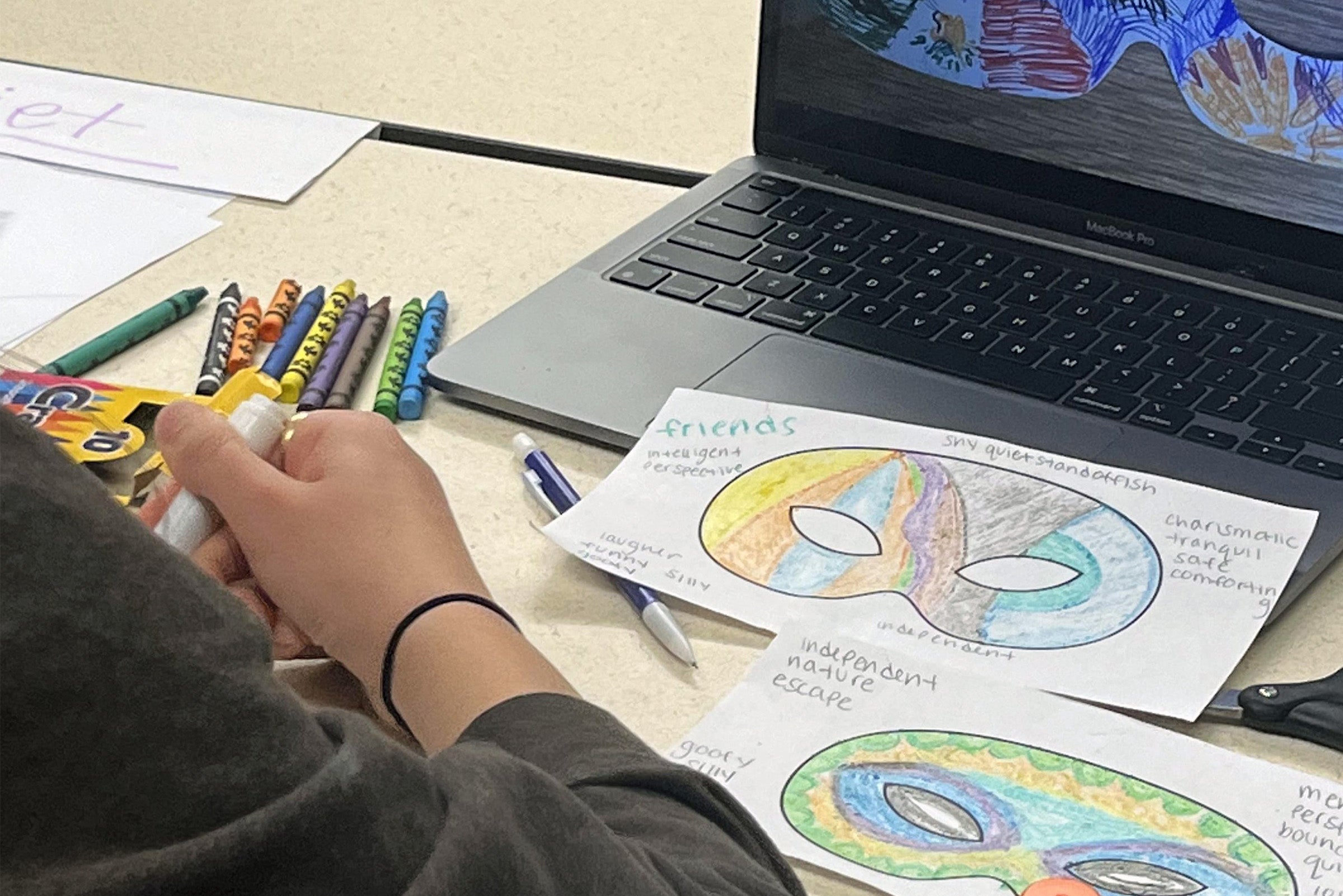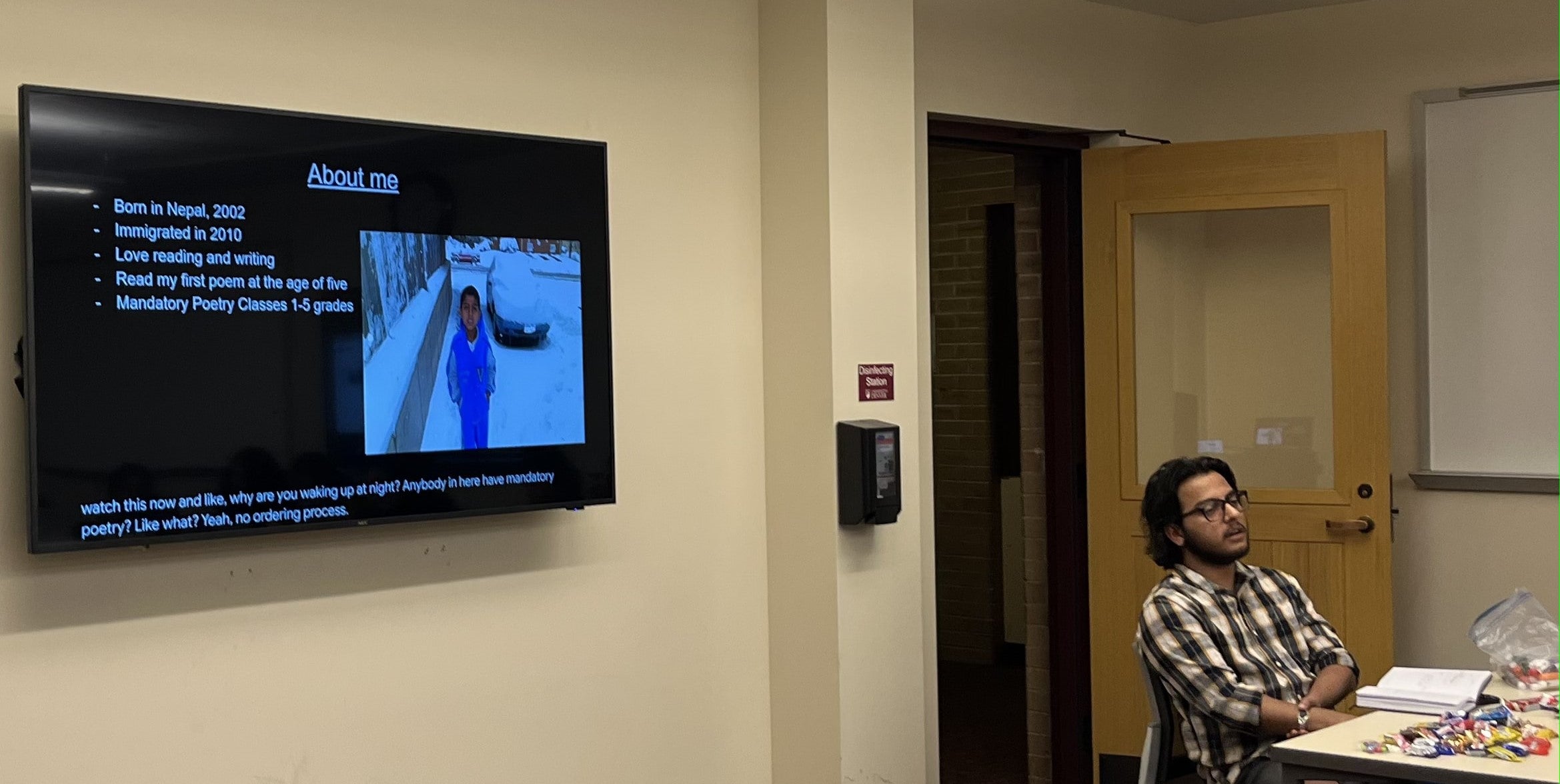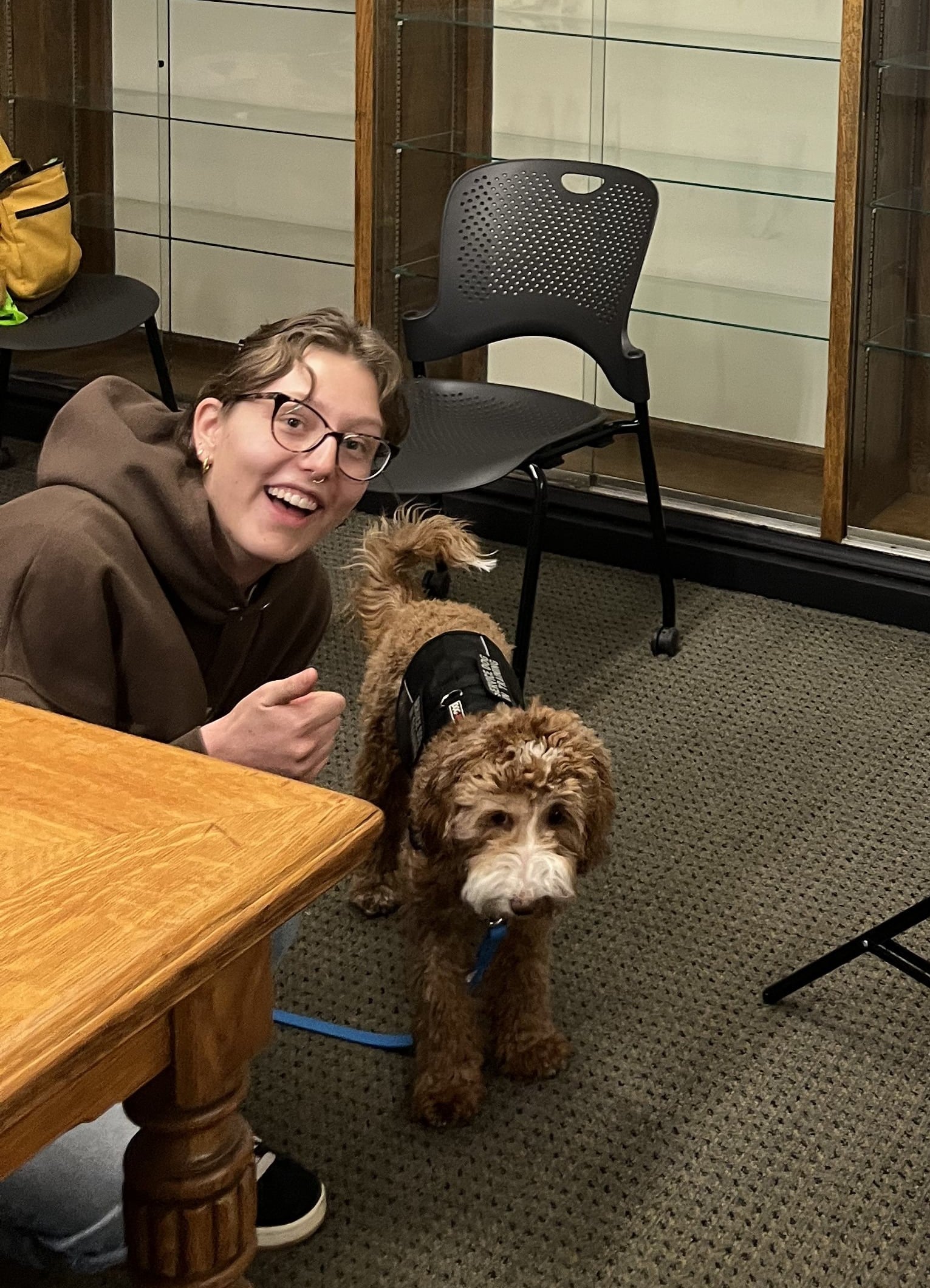Student-Professor Teaching Collaborations for Well-Being
“I thought it was cool and I showed my roommate my masks. I also applied it to other things in life.” —Juliet Cargill
“I really enjoyed the student-led class and it's super cool seeing how connected other people are to their identities, it's inspiring. Makes me think I can do it!” —Devin Hernandez
It is not every day that students call class lessons inspiring or share class materials with their roommates. We, a group of students and a professor, have found that students feel empowered when they experience personal lessons designed and taught by their peers.
Co-authors: RJ Justice, Bedha Neopaney, Roman Trammell, Gabriela Coral Zubia, Juliet Cargill, Devin Hernandez, Hannah Rosenberg, Jacob Nitzkin, Ashley Gonzalez Ovalle, Ana Júlia Rodrigues Alves, Janelyn Geronimo, Calley Marotta
The Project Beginnings
In 2023, I was a new Teaching Assistant Professor in the Writing Program. I was designing an introductory writing course titled Language and Writing Justice that involved students analyzing writing and language inequities in order to design writing interventions. As a white monolingual and able-bodied educator, I drew from critical participatory and liberatory research in education (Love, 2019; Patel, 2015) and writing studies (Keleyni, 2023) to center the experiences of students directly impacted by the course content. I utilized a DU Faculty Research Fund grant to collaborate with Writing Program student award recipients, Ana Júlia Rodrigues Alves and Janelyn Geronimo. Together, we designed lessons inspired by their first-hand experiences with accent discrimination and Hawai’i pidgin respectively. After we collaboratively facilitated the lessons, students enrolled in the classes reported that Ana and Janelyn’s teaching was particularly empowering for their learning and overall well-being. I applied for a 4D Infusion Grant to support and expand these teaching collaborations.
Thanks to the 4D grant, we extended the project across multiple classes for first-year and transfer students by funding four student-collaborators to design and facilitate lessons. The student-collaborators were not enrolled in the classes and were recommended by colleagues for their experiences with the course topics, disability and language justice. In initial meetings as a group, the student-collaborators and I discussed the course and where their lived experiences, talents, interests, and motivations might compliment course content. Students shared experiences with neurodivergence, anxiety, multiculturalism, and multilingualism along with interests in therapy, art, and activism. Drawing from my pedagogical experience, we designed activities that leveraged students’ lived experience and the lesson learning outcomes. I mentored students on engagement strategies while students mentored me on student experiences. In the process of collaboratively facilitating the lessons, I provided context and facilitation support while the student collaborators led activities.
Sample Student Lessons and Activities
Below, you will find images from the student-faculty collaborative lessons. The first two images are from WRIT 1122: Writing and Language Justice, a course in which students use writing to create dedications (Gumbs, 2019), interview poems, and speculative nonfiction (Butler, 1979; Brown and Imarisha, 2015) to challenge writing and language injustice. The second two images are from WRIT 1533: Writing and Researching for Access. In this course students use disability justice (Sins Invalid; Piepzna-Samarasinha, 2018) as a theoretical framework to design accessible methods for qualitative research about access. During the lessons, student-collaborators modeled access, creativity, and empowerment. By doing so, they gave students enrolled in the classes permission to actively engage in their learning as part of their well-being.
Multiple Masks: Code-Switching and Code-Meshing in Everyday Life
In her lesson, student-collaborator Gabriela Coral Zubia drew from Gloria Anzaldúa’s scholarship to model code-switching and co-meshing as a writing and language justice method. During the lesson, students designed different masks for their communication in different contexts. They then combined the masks and practiced code-meshing in poetry. The image below shows a student designing her mask based on Gabriela’s example meshing her student and cultural identities. In the exercise, Gabriela empowered students to identify and use their language practices for their own benefit whether they were switching or meshing their communications together to integrate their experiences.
As a learning outcome, Gabriela also wanted students to understand that art can be an expressive and fun way to learn. For Gabriela, “Seeing everyone color and create designs for their own masks” was the best part. “Some were laughing, some were communicating about why they chose the design that they did. Everyone had such unique masks. Watching everyone loosen up and have fun was my favorite part as well.”
As a professor, I was astonished by Gabriela’s influence. I offer fidgets every class to help students focus, but I noticed few students used them in the first few lessons. During Gabriela’s lesson, she used a fidget while she was facilitating the class. I saw an immediate increase in students’ comfort using fidgets and access measures to support their learning. This instance reminded me that student modeling is powerful. Reflecting on the experience overall, Gabriela says, “It is definitely an experience that I will be talking about to my friends and family, it is also such a good experience for somebody that is considering teaching as a career. It made me more confident in the sense that I feel I can take on bigger things now without feeling anxiety.”

Comparative Contexts for Poetry: US and Nepal
Students extended their understanding of linguistic choices in poetry by learning from student-collaborator Bedha Neopaney’s multinational experience with poetic forms. In his lesson, Bedha Neopaney reflected on his experience growing up with poetry, first in Nepal, and then in the US. Through modeling and guided questions, Bedha taught students to analyze poetry in light of specific cultural contexts. Students then practiced translating Old English to languages of their choice in order to experience the affordances and constraints of writing across historical, sociocultural, and political contexts. The image below shows Bedha describing the screen which shows him as a child in a blue tracksuit experiencing his first snow. Overall, Bedha’s lesson modeled how students can use personal experiences and knowledge across contexts, including cultures and languages, to understand how writing is rhetorically situated.

Ethical Research Methods and Neurodivergence
In the research and writing course, students were preparing to facilitate accessible focus groups. RJ Justice taught students about researcher accessibility through the lens of neurodivergence. They shared their own experience engaging in research in order to highlight challenges for researchers with disabilities as well as principles and strategies to support accessibility for both researchers and participants. RJ then taught students to create clay models that allowed students to design spaces and materials to center access during their focus groups.
RJ reflected on the insights they gained from the process of collaboratively teaching: “The process gave me a deeper appreciation for the work professors do for each and every class. It helped me grow, as I was vulnerable about something I was passionate about in front of people I didn't know; this was also something I'd never done before. As far as wellness goes, this helped me feel like I could really make a difference in classrooms and at DU overall.” “My favorite moment was definitely getting to be in the classroom and talk to students and hear their thoughts about different aspects of the work they were doing (research, accessibility), and how I could contribute to the conversation with my own experience.”
Engaging with students after RJ’s lesson, I was amazed by the lessons’ impact. In several instances students enrolled in the classes repeated language from the student collaborators in other class sessions. One student quoted RJ, describing that “everyone has access needs” as a part of their research. This instance showed me that student collaborators’ explanations resonated with students in ways they will transfer beyond the lesson.

The image shows RJ facilitating with their service dog, Stevie.
Mental Health as Writing and Research Accessibility
Complimenting RJ’s work, Roman Trammell drew from their personal experience and knowledge to help students create accessible focus groups through value-based frameworks. These frameworks provided a specific way to reflect on mediating anxiety within their lives and focus groups. As a part of their lesson, Roman utilized technology like Mentimeter to help students engage with the topics. These methods allowed students to respond confidentially while also visually recognizing shared experience amongst the group. Roman additionally brought their lived experience as a transfer student to this specially-designed transfer student section. The image above shows how Roman Trammell used a mentimeter to help students reflect on their own mental health.
Roman reflected specifically on how the lesson design and facilitation supported their own wellness. They said, “Wellness for me includes growth. I was able to face a recurring challenge for me: presentations, and share my passion and the lessons that I have learned with my peers. That was a challenging and rewarding process. They enjoyed “the journey and having completed it and seen myself succeed.”
Roman equally influenced students’ wellness by modeling how students can bring their whole selves to class and make learning and facilitating accessible for them. By simply supporting their own access needs, and sitting down to present, Roman challenged traditional assumptions about who can be a presenter and a researcher. They gave students permission to honor their own access and design environments for that would honor the needs of their group.
Empowered and Engaged
In informal survey data, students’ enrolled in the classes reported that the co-taught lessons increased their learning because they felt empowered and engaged by their peers. Below I have included three student responses that reflect these broader trends.
“I liked the student-led class. I thought it was really cool that she was up there doing it, and the information felt really relevant and important. I took away that we all have different masks that we put on in different scenarios and some can be good, but some can also be very negative and oppressive. I think getting to learn from other students is a positive perspective for my learning because I get to hear my peers’ opinions.” —Hannah Rosenberg
“I really enjoyed it, especially because it was so interesting, and it was someone of our age who was doing so. She was very fun, and the activities were different from normal classes, so it was engaging and it helped me learn a lot more.” —Ashley Gonzalez Ovalle
“I took away that the capabilities of someone in our grade level can be very high, and leading an entire lesson was very impressive. From that class, I learned what code-switching is, something that I didn't realize was a distinguished concept with a term. The class format has kept me engaged and positively affected my learning.” —Jacob Nitzkin
Want To Learn More?
Drawing from all of the student-collaborators, RJ Justice and I have designed a workshop to share with other educators and students. We have also designed these planning materials with linked resources to help support student-professor teaching collaborations. If you are interested in learning more, please reach out to Calley by email.
References
Anzaldúa, Gloria (1987). Borderlands/La Frontera. Aunt Lute Books.
brown, adrienne maree and Walidah Imarisha (ed) (2015). Octavia’s Brood: Science Fiction Stories from Social Justice Movements. AK Pres.
Butler, Octavia (1979). Kindred. Doubleday.
Gumbs, Alexis Pauline (2019). “The Sweetness of Salt: Toni Cade Bambara and the Practice of Pleasure (in Five Tributes).” in adrienne maree brown, Pleasure Activism: The Politics of Feeling Good. AK Press.
Keleyni, Gabrielle Isabel (2023). “Participatory Pedagogies: An Approach to Meeting the Needs and Elevating the Desires of Adult Undergraduate Writers.” The Sandbox 1, no. 1. Community Literacies Collaboratory.
Love, Betina (2019). We Want to Do More Than Survive: Abolitionist Teaching and the Pursuit of Educational Freedom. Beacon Press.
Patel, Leigh (2015). Decolonizing Educational Research: From Ownership to Answerability. Routledge.
Piepzna-Samarasinha, Leah Lakshm (2018). Care Work: Dreaming Disability Justice. AK Press.







